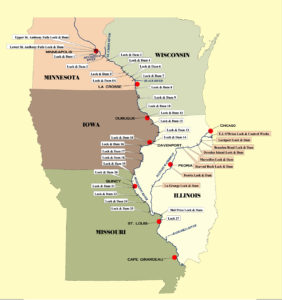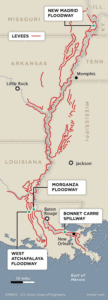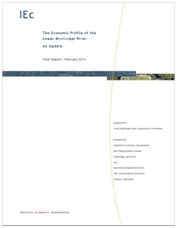// By Brad Walker, Rivers Director December 11, 2015
Introduction
How do we value a river system? What should we count? What should we prioritize? If we decide to place dollars on everything, will that further commodify a river? If we don’t place dollars on everything, will it lead to bad decisions? All of these, and many others, are interesting questions that need consideration.
At the request of river interests, economic studies separately profiling the Lower and Upper Mississippi River basins have been completed by Industrial Economics, Incorporated over the last several years. The motivation for preparing these profiles is to attempt to document the volume of economic activity generated near the river in order to justify additional governmental spending on infrastructure, theoretically then increasing economic growth in these regions.
There are unstated underlying assumptions implied within these profiles that include:
- The economic numbers are accurate
- Greater economic growth is always better
- Economic growth will provide increased human wellbeing
- Increased economic growth will not have damaging impacts
- By showing these economic numbers to decision makers we can properly increase investment in and near the river
Although the numbers are likely accurate, because these studies were based upon the erroneous philosophy of infinite resources, as reflected in our national development policies, the above assumptions are largely false. The studies admit that they do not quantify all of the values associated with the river. In fact, they do not document the primary value of a river system, its ecosystem services. By doing this they relegate the river value largely, though not completely, to the exploitation of its natural resources for economic gain, while ignoring the environmental and associated economic losses caused by these exploitative activities. This problem is discussed in a recent article titled Time to Stop Worshiping Economic Growth and more recently in an interview on National Public Radio – Questioning our Growth Fetish.
This is a distortion of our values because it not only allows, but encourages, us to destroy river environments for short-term and unequally distributed economic gain. By doing this we also impoverish future generations.
Background
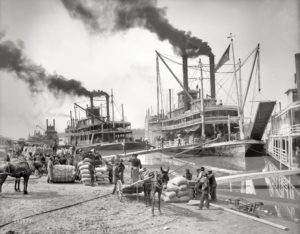
The initial development of the middle of our country during the early 1800’s was primarily along our rivers because of certain inherent advantages:
- Efficiency of water transportation as compared to horses,
- Natural food sources were easily found within and along the river,
- Flat floodplains provided fertile soil for agriculture and level places to build communities,
- Vast forests supplied trees for lumber and fueling steamboats,
- Rivers supplied water for development and our waste
River infrastructure evolved over the 19th and 20th centuries to support larger boats to transport more products in a safer manner. Constructing infrastructure in water is expensive and subject to damage from floods requiring considerable maintenance. The construction of the river infrastructure has also created major changes to their hydrology and their channel configuration.
Other transportation modes such as railroads and trucks have been developed that compete with, and to a lesser extent work with, river barges.
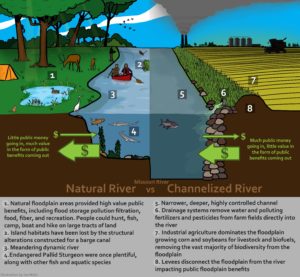
Before the major navigation infrastructure, primarily locks & dam and channelization structures, on the UMR and Missouri River was built, US Army Corps of Engineers staff predicted that its construction would cause significant harm to the environment and would never be economically self-supporting. They were correct on both accounts; river infrastructure has severely degraded the river and it is almost totally funded by the taxpayers.
Agriculture spread into the floodplains, which were leveled, leveed off, drained, and eventually transformed into intensively produced row crop agriculture. This cut off the river from its floodplain and concentrated industrialized, chemical-dependent farming within a vulnerable environment.
Power companies also took advantage of the river water, level land, and cheap subsidized transportation costs to construct huge coal-fired and nuclear power plants in the floodplain. Other industries and municipalities also took advantage of the rivers for a source of water and a waste sink for their effluents.
Today’s Realities
|
|
We have built an immense amount of infrastructure in this country, most of it during a time of misleadingly cheap and abundant oil. The cumulative effects of much of this infrastructure upon the river and its floodplain have been dramatic, but because so much time has passed since its construction most people are unaware of the benefits that a natural river used to provide or even what a natural river looks like. Some people call this landscape amnesia.
For various reasons, a harsh reality has crept upon us – there is no longer enough federal-level revenue to fund everyone’s infrastructure projects across the country. Unsurprisingly, competition for federal funding is high while states and local revenue sources are at least as equally stressed as the federal government.
There is a strong desire by local and regional river interests to generate greater government funding for the infrastructure they use along and in the river. In the hope of gaining an edge with Congressional appropriators, economic profiles have been drafted for both the LMR and UMR to attempt to quantify the economic value of the Mississippi River. But at least one major question remains unanswered – does it make sense to throw good money after bad if we have actually been funding the wrong activities in our rivers. A more comprehensive analysis may very well support major modifications or removal of some or even much of this infrastructure.
LMR Economic Profile
The first of these profiles covering the Lower Mississippi River (LMR) was released in February 2014. I attended a meeting in Memphis in October 2013 where the profile was previewed by the primary author. It was intended to “develop a profile of the regional economic activity dependent upon the Lower Mississippi River” and it covers counties along both sides of the Mississippi River from Cairo, IL, to New Orleans as well as several counties along major tributaries. Listed below are several important assumptions and criteria we have gleaned from the profile. Several of these will be discussed in detail later in this paper.
- Assumes all economic activity for items included are attributable to the river
- Makes adjustments for lack of local data using state or federal statistics
- Covers ten economic sectors
- Uses a traditional economic analysis that assumes all economic activity is positive
- Estimated that the “annual revenue” was $151.7 billion
- Did not quantify the tenth sector – Ecosystem Services
UMR Economic Profile
The second of these profiles covering the Upper Mississippi River (UMR) has not been released as of the first of December 2015 but some details have been provided or are known. This profile covers the river from the Twin Cities to Cairo, IL, but does not include Illinois River. From what we understand, the same organization has prepared it and has used the same methodology for the LMR profile. The six assumptions and criteria we list above for the LMR apply except that the “annual revenue” was estimated to be $251 billion.
Do these Profiles relate to Human Wellbeing?
The implication by providing the public with these economic profiles is that an accounting of human wellbeing from the river economic development is established. However, both river economic profiles follow what can be classified as a Gross Domestic Product (GDP) methodology of accounting for calculating the “annual revenue” – by counting up economic transactions.
There are numerous problems with using GDP as a human wellbeing, or standard of living, measure and they are briefly documented in our blog article “Ending Overdrafts”. We quote a section from the article below:
GDP totally fails to account for the losses or the degradation of our renewable natural resources including losses in wetlands, soil fertility, prime farmland, old-growth forests, rivers, aquifers, and fisheries. It also ignores the diminishing of our nonrenewable resources including metals, minerals and petroleum. Further, as hard as it might be to believe, GDP considers money spent dealing with floods, forest fires, hurricanes, tornadoes, crop failure, illness and disease (such as cancer), auto accidents, and even war as positive economic activities despite their negative impact upon the physical realities of the planet and its inhabitants.
When negative and costly events are measured as positive and contributing to the economy, it leads decision-makers and us to a false view of our economic, social and ecological condition. It hides the growing economic and ecological debt which makes it understandable then why those decision-makers make so many bad decisions and why much of the general public is not up in arms about the results of those bad decisions even though we pay the bills. We are not counting what matters.
The economic profiles automatically transforms the economic transactions used to their absolute values; thus if it is a negative transaction, it becomes positive in GDP.
Critique of LMR Study
We asked an ecological economist, Eric Zencey from the Gund Institute for Ecological Economics at the University of Vermont, to review the Lower Mississippi River Economic Profile and provide us with his thoughts. We had expected a page of critique but instead we received a 25-page review titled A GPI-based critique of “The Economic Profile of the Lower Mississippi River: an Update”. His paper also provides proof of why analysis by ecological economist is so important. They understand that economies are founded upon a healthy environment, not the other way around as mainstream economists preach.
Several of his main points are provided below:
While agriculture in the river’s fertile bottom lands is, as the LMR Report notes, the third largest revenue-producing sector in the LMR Corridor’s human economy, and while “arguably the most important factor” in the success of that agriculture is the richness of the alluvial soil deposited by the river (Report, p. 6-1), dams and locks have diminished the amount of soil-building sediment transported by the River by more than 70 percent since 1850. Sediment loss and flood prevention have starved soils (and the non-human economy of the LMR Corridor in general) of needed nutrients and building material. Agriculture must thus rely on unsustainably sourced fertilizer or on unsustainable draw-down of soil fertility (a.k.a. “soil mining”). See Page 3
Clearly, something is bedeviling us, generating paradox. Some parts of the LMR Corridor economy appear to be systematically poisoning, degrading, even annihilating the foundation of other parts of that economy.
Expenses that should be counted as costs are ignored or mistakenly counted as benefits. By standard measures the economy of the LMR Corridor is apparently healthy, even setting historical records, yet the river itself is disturbingly sick. See Page 5
While some economic activity detailed in the Report can be seen as benefiting directly from ecosystem services provided by the river (transport by barge, river-related recreation and tourism, etc.), and while the Report does acknowledge the existence of ecosystem services related to the river, much of the economic activity described in the Report has little to nothing to do with the river. …. most importantly, the Report analyzes the human economy in the LMR Corridor according to traditional measures and metrics that are incomplete, misleading, and just plain wrong-headed. The chief problem is the Report’s reliance on Gross Domestic Product, GDP, as the primary measure by which economic activity is assessed. See Page 6

Nowhere does the Report mention, let alone assign a value to, the ecosystem services that were lost as a result of decisions made about river management and economic development within the LMR Corridor. …. Of particular interest to those concerned with the economy of the LMR Corridor will be the incorporation into GPI methodology of estimates of the ecosystem service value of flood plains (and, on the other side of the ledger, the costs associated with denying the river access to its historical floodplains). See Page 24
The standard modes of economic analysis used in the LMR Corridor Economic Profile don’t give policy makers accurate information. …. A full and accurate accounting of all relevant costs and benefits of economic activity is needed to illuminate the path to optimal policy in the LMR Corridor as elsewhere. See Page 25
Comments/Suggestions
We have too much infrastructure in this country to maintain. A rational decision-making process needs to be established that periodically and objectively evaluates systems to determine if they are worth keeping. For example, some of our past projects were unjustified when they were built, or the technology that justified them is now outdated, or the investments no longer makes sense.
We have been stuck in an inefficient project authorization system that is primarily about wheeling and dealing to protect or expand parochial investments. But we have not included all of the costs and have over-estimated the benefits for some of the infrastructure; yet we have also never made adjustments to the process for these short-comings, allowing us to continue to pour money into bad projects.
Jobs are important, but building bad projects solely to create jobs makes no sense and ends up robbing future generations and burdening them with infrastructure albatrosses. Unfortunately, some current/traditional investments do provide a small group of people and corporations significant benefits (specifically navigation infrastructure and the disconnection of floodplains to the river with agricultural levees) and their influence is overwhelming in Congress; and increasingly they are influencing state governments – and even local government (think pro-football stadiums).
Regrettably, these same bad investments have impoverished the rest of us – economically and ecologically. The valuable ecosystem services lost from the construction of most of the river infrastructure need to be restored as quickly as possible. The benefits from a healthy, functioning and productive river will reverse the ecosystem services losses, reduce infrastructure cost obligations, and provide a large net return to the public.
It is imperative that we immediately begin to include the true and total cost and impacts of degrading our natural resources and ecosystems within our economic analysis. It is better to use rough estimates until more precise numbers are established than to use the number we have been using for at least 100 years – $0.
We need to acknowledge that not all economic activity is good and should thus be counted as a negative within our economic analysis. This would then discourage us from continuing these detrimental activities or at least incentivize our society to charge the costs to those who cause the impacts.
And finally, all levels of government need to start incorporating the GPI system, or something equivalent, into their economic analysis to provide needed information for better decision making.
Closing Thought
No discussion of sustainability is contained within the economic profiles and I expect it was never intended to be a part of the profiles. It is assumed that what we have been doing can continue forever. This is totally untrue and invents a false sense of security; in fact, it actually leads us to believe that we can increase our level of resource exploitation. The absolutely most important sector of the ten included in the profiles is the ecosystem services because these services are the underlying source of economic development and by connection – human wellbeing. The ecosystem services are being depleted and activities must be altered to accommodate their recovery. As they are currently written, these economic profiles will only promote further decline in ecosystem services and increase future problems.

